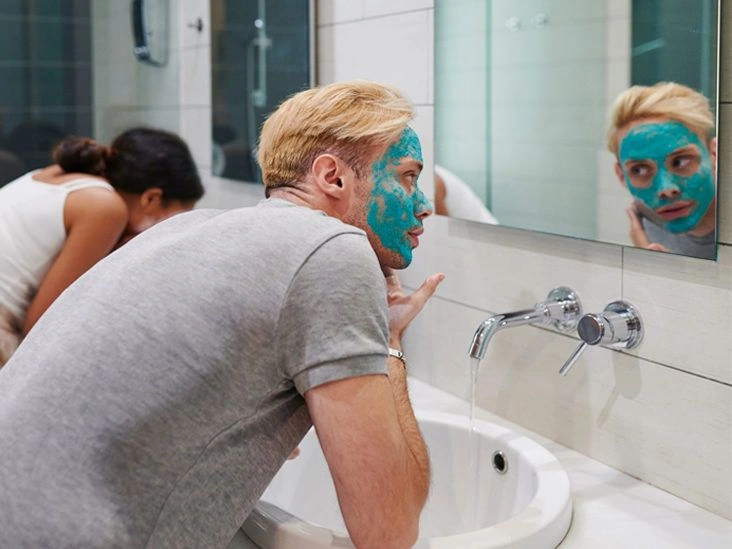People have relied on clay for generations to enhance the condition of their skin and hair.
Facial masks made from clay come in several varieties, such as kaolin or bentonite. They are believed to offer multiple advantages, including absorbing surplus oil, helping control dry skin, and reducing acne.
While much of the support for clay masks is anecdotal, a number of studies indicate these masks may be effective.
This article explores the possible benefits of clay masks for skin and hair and reviews any known side effects.
Potential advantages of clay masks for acne
Clay masks can help draw oil from your skin and may prevent mild acne types, like pimples and whiteheads. These blemishes typically occur when pores become clogged with excess sebum and debris.
To address blackheads, acne, or other spots, applying a paste of clay powder mixed with warm water is recommended. The warmth encourages perspiration and promotes the release of oils and impurities from the skin.

For more severe cystic acne, consult a healthcare professional about appropriate treatments. A clay mask won’t resolve underlying causes such as hormonal imbalances.
Clay masks for unclogging pores and oily skin
Putting a clay mask on your face helps pull excess oil from the pores. Many users report that green clay is particularly effective at mattifying oily skin.
If your skin is naturally oily, using a clay mask once or twice weekly may help control oil production.
Treating dermatitis, psoriasis, eczema, and rosacea
According to a , a lotion containing quaternium-18 bentonite, a form of bentonite clay, may reduce symptoms of dermatitis caused by poison ivy and poison oak.
Bentonite applied to diaper rash was also shown to be more effective than a standard calendula treatment.
There’s limited research on using clay masks for conditions like psoriasis, rosacea, and eczema, though many individuals report symptom relief with clay treatments.
has reported that bentonite clay may assist in treating ulcers and cuts. Animal studies indicate clay masks might stimulate collagen fiber production, which could reduce wrinkles and increase skin firmness.
Clay masks and dry skin
Red clay is occasionally recommended for dry skin. A 2016 study found that as clay dries, it forms a film that may aid in moisture retention.
However, researchers did not observe a significant short-term improvement in skin firmness after using a clay mask.
Excessive use of clay masks can potentially dehydrate your skin. If your skin is already dry, consider limiting usage to no more than once a week.
Clay masks and toxins
Clay typically carries a negative electrical charge. suggests this negative charge might allow clay to bind positively charged toxins and heavy metals like mercury and lead present in environmental pollution.
Benefits of bentonite clay masks
Bentonite is a clay formed from volcanic ash. Its name comes from Fort Benton, Wyoming, where significant deposits were found.
A number of studies investigating the benefits of clay masks have focused on bentonite clay.
Some potential ways bentonite may benefit skin include:
- reducing excess oil
- protecting skin from certain toxins
- helping to diminish acne
- alleviating dermatitis symptoms
- improving diaper rash outcomes
How clay masks may help hair
Most claims about clay benefiting hair are anecdotal. While more research is needed, some believe clay can extract dirt and oil from the scalp, supporting healthier hair.
Clay masks for hair may assist with:
- dandruff
- dry, damaged hair
- frizz
- heat-related damage
Some people suggest clay can accelerate hair growth, but this appears to be a misconception, possibly stemming from a that found bentonite improved wool production in sheep. There’s no evidence clay promotes hair growth in humans.
Possible side effects and precautions
Serious adverse effects from applying a clay mask are unlikely.
If left on too long or used too frequently, a clay mask can cause dryness or irritation. It’s advisable to use clay masks no more than twice per week.
Certain clay masks may include additional ingredients, such as glycolic acid, which could irritate sensitive skin.
Common side effects of clay masks include:
- dryness
- itching
- redness
- rashes
How to apply a clay mask
Follow these steps to apply a basic green clay mask:
- Take a quarter-sized amount of clay from the jar.
- Apply the clay evenly over your face, starting from the lower neck and moving upward.
- Leave it on for around 15 minutes.
- Rinse off with lukewarm water or a moist cloth.

Where to purchase clay masks
Clay masks can be bought online or at most retailers that sell skincare products.
Conclusion
Clay facial masks have been used for centuries to support skin health.
Contemporary research suggests clay masks may offer several benefits, such as absorbing extra oil and helping to prevent acne.
Anecdotal reports also indicate potential benefits for hair when using clay masks.
If you decide to try clay masks, limit use to twice weekly, as dermatologists often recommend to prevent skin dryness from overuse.


















Leave a Reply
You must be logged in to post a comment.